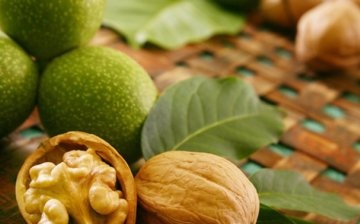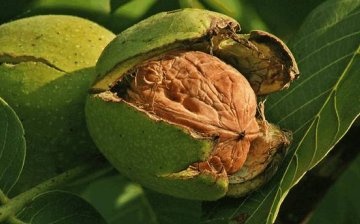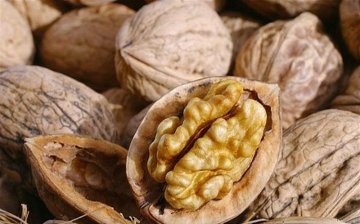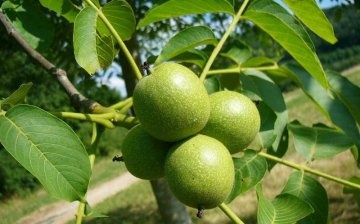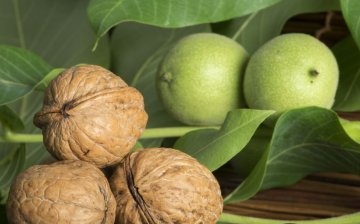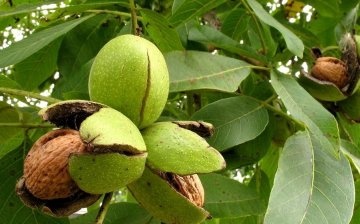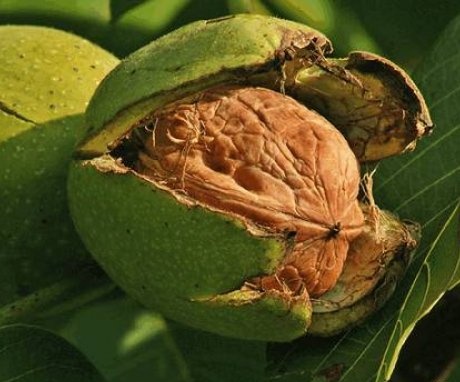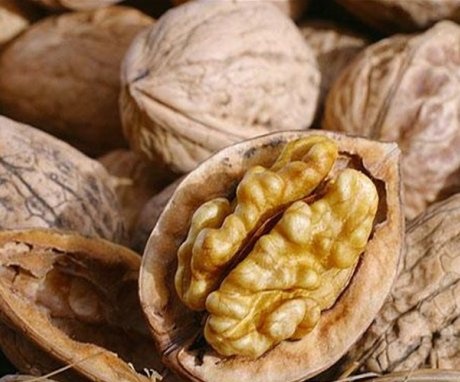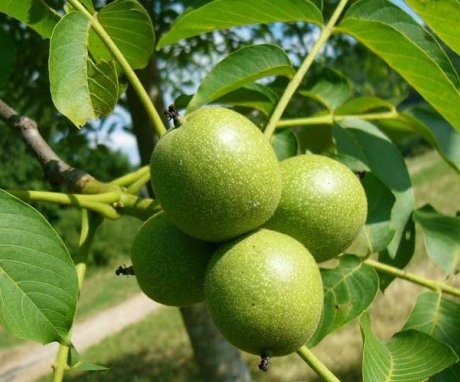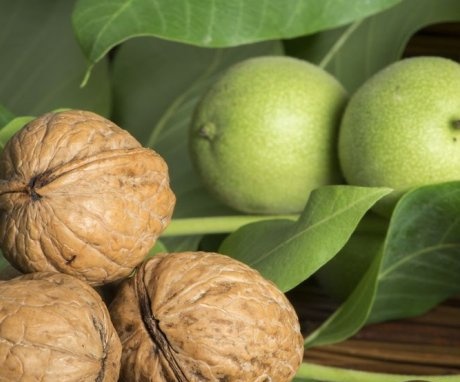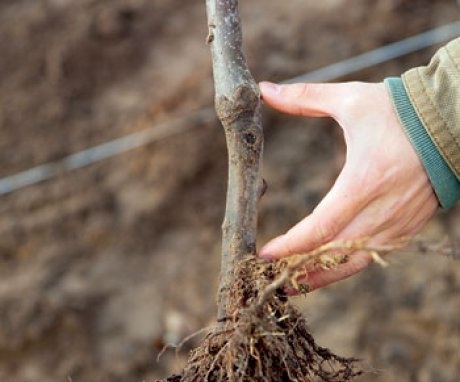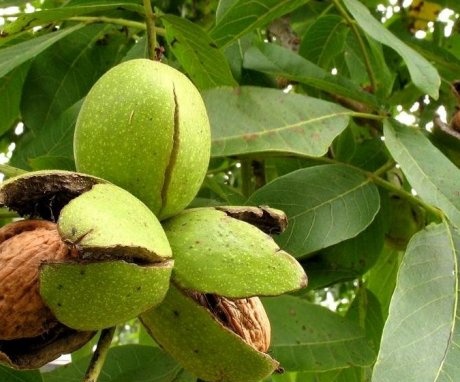Walnut - the best varieties, planting and proper care
It is widely believed that walnuts can be grown exclusively in warm regions and in very large areas. Nevertheless, at present, quite a lot of frost-resistant varieties have been bred. walnutsuitable for cultivation in areas with harsh climates, and many early maturing varieties that do not require a very large space.
Content:
- Features of the structure of a walnut
- Varieties
- Growing conditions
- Reproduction
- Site preparation and landing
- Wood care tips
- Pest and disease control
Features of the structure of a walnut
Walnut - a deciduous tree with a large spreading crown, growing up to 30 meters in height. The trunk diameter reaches one and a half meters. The tree is characterized by rapid growth and by the age of six it can already reach 3.5 meters. The main shoots and trunk are powerful and thick. The bark is gray, smooth, with cracks in mature trees. The leaves are large, elliptical.
Walnut is a wind-pollinated monoecious plant with dioecious flowers.
The formation of female flowers occurs on the growth of the current year in the lateral and apical buds, and male flowers on the branches of the previous year in the lateral buds. Female and male flowers bloom at intervals of seven days. Walnut buds are of two types: vegetative (shoots develop from them) and generative (from which flowers are formed).
The walnut has a highly developed rod-type root system, with numerous lateral branches that can grow beyond the crown.
Varieties
Many varieties are currently cultivated walnutcharacterized by frost resistance, good fruit quality and high yield.
The most popular walnut varieties:
- Dessert - does not tolerate frost, therefore it is suitable for cultivation in regions with a mild climate. The variety is high-yielding, with an early ripening period, the fruits are sweetish. Begins to bear fruit for 4 years, each tree yields a crop weighing up to 25 kg.
- Graceful - the variety is resistant to drought, frost, to diseases and pests... The fruits ripen in the 5th year of life. Productivity - up to 23 kg per tree.
- Abundant - the variety has a reduced winter hardiness, but is resistant to brown rot. Bears fruit in the 4th year. Productivity - up to 30 kg of nuts from each tree, fruits are distinguished by excellent taste.
- Yielding - the variety is resistant to frost and disease (medium). The harvest begins to ripen from the age of 3 years. Fruiting is regular. Up to 29 kg of nuts are harvested from one tree.
- Aurora is a frost and disease resistant variety. It differs in that the yield increases every year.
- Ideal is the most popular variety among gardeners. Withstands frosts down to minus 35 degrees, does not need shelter for the winter. The fruits begin to ripen from the second year. Over the years, the yield increases, from one ten-year-old tree up to 120 kg of nuts are harvested per year. The ideal bears fruit twice a year, reproduces only seeds.
- Giant - in popularity is in second place after Ideal. It is also hardy and high-yielding, but the fruits begin to ripen in 4-5 years.
In regions with a mild warm climate, early-growing walnuts are grown, which are characterized by:
- Small tree height.
- Fruiting from 3 years of age.
- Early ripening of fruits: early August.
- High yield.
- Intolerance to frost.
The best varieties of early-growing nuts:
- Dawn of the East
- Breeder
- Five-year plan
- Petrosyan's favorite
Growing conditions
Walnut grown in well-lit areas. It can be planted on any slopes, except for the southern southwestern ones. The fact is that on the southern slopes the land warms up faster, and accordingly, the trees wake up earlier, which reduces their winter hardiness. In addition, in such areas there is a great difference between day and night temperatures, so plants suffer from burns during the day and frost at night.
Walnuts require a lot of space: they are planted according to the scheme 8 x 10 or 10 x 12 meters.
Small areas for growing a tree are not suitable, with the exception of early maturing varieties that have a small crown and size. The type of soil for planting a nut is moderately moist calcareous loam, sod-podzolic, sod or super sandy soil (humus content 3%), groundwater should not rise more than two meters to the surface.
On very swampy and compacted soils, the nut does not take root. The soil should be loose and moisture-retaining. The level of soil acidity is 5.5 - 5.8 pH. Soil fertility must be maintained without fail. Good results are obtained landing under the green manure tree: lupine, peas, oats.
Reproduction
The walnut is propagated in two ways: by seeds and by grafting. Seeds are collected only from walnut varieties that grow in your area. Choose a sturdy, healthy tree with good yields: up to 20 kg dry walnut per 30 year old tree.
The ripeness of the fruit is determined by the green shell - the pericarp: it should begin to crack and easily separate when cut.
The collected nuts must be immediately cleaned of the pericarp and dried for 7 days in the sun, then under a canopy. Finally, the fruits are dried in a room at a temperature of 20 degrees. For sowing, you need to select large nuts of the correct shape, without flaws.
Reproduction by seeds:
- Walnut seeds are sown in autumn and spring. When sowing in spring, the nuts must be subjected to stratificationotherwise they will take a very long time to sprout. The duration of the procedure depends on the thickness of the shell: nuts with a thin shell are stratified at a temperature of 15 degrees for about 40 days, seeds with a thick shell are processed for about 100 days at a temperature of 5 degrees.
- To obtain uniform seedlings, before planting, the nuts are kept in the sand at a temperature of about 18 degrees until they begin to germinate.
- After that, sprouted and non-sprouted nuts are sown separately, the latter are more dense.
- Nuts are planted in April after the soil has warmed up to 10 degrees in the soil prepared in advance.
- Large nuts are placed at a depth of 11 cm, medium nuts at a depth of 8-9 cm. The seeds must be placed on the edge, then seedlings get straight.
- When sowing in open ground the nut germinates slowly, and seedlings ready for planting in a permanent place in the garden can be obtained not earlier than after five years, for rootstocks - not earlier than after 2 years.
- To speed up the growth of seedlings, the seeds can be sown in film greenhouses, then the plant will be ready for planting in two years, and for rootstocks in a year.
- Seedling care consists in loosening the soil, mulching, weeding and watering in dry weather.
For reproduction by grafting (the most common method is budding), seedlings at the age of 2 years, grown in a greenhouse (available for purchase), are used for the stock. The best time for budding is the period of sap flow (early or mid-June).
For budding to be successful, it is important to harvest quality cuttings from healthy, high-yielding trees.Cuttings should be straight, from 30 cm long, with well-formed axillary vegetative buds.
Budding technology:
- On the rootstock at a distance of 10 cm from the surface of the ground, make two transverse cuts.
- Make 2 longitudinal cuts to form a rectangle.
- Separate the bark.
- The same is done on the handle so that the eye is located in the middle of the rectangle.
- A "rectangle" (shield) is attached to the place of the removed rootstock bark stalk.
- Tie the place of attachment tightly with polyethylene, leaving the petiole and peephole open.
- The harness can be removed after 25 days.
- The next spring, after the buds are swollen, the stock should be cut over the flap at an angle of 70 degrees.
- Cut off the shoots growing on the rootstock during the growing season.
Site preparation and landing
A hole for planting a walnut is prepared in the fall:
- Dig a hole 60 x 60 cm deep and in diameter in fertile soils and 100 x 100 cm in less fertile soils.
- Set aside the fertile layer separately, remove the rest of the soil outside the site.
- Mix the fertile layer with peat and humus (or compost) in equal proportions.
- Take 800 grams of potassium chloride, 3 kg of superphosphate and about a kilogram of dolomite flour and mix with the soil mixture.
- Fill the hole with the resulting soil.
Planting seedlings in spring:
- The soil in the pit must be mixed again and removed.
- Place a peg about 3 meters long in the center of the pit.
- Fill the pit 2/3 with the mixture.
- Drizzle with water (one or two buckets).
- Spread the mound so that the horse's neck of the seedling is 5 cm above the soil surface.
- Remove diseased roots from planted trees.
- Dip the roots in a talker with a growth stimulator.
- Place the seedling on a mound and sprinkle with the remaining soil mixture.
Wood care tips
The walnut forms a crown on its own, therefore, in pruning does not need. If there is a need to delete any branches, they are pruned in stages:
- In the first year in June (not in spring!), 7 centimeters in length are left at the shoot.
- In the second year, they are pruned to the base and the cut site is treated with a garden pitch.
Young seedlings require a lot of moisture during the growing season. Watering carried out once every 14 days: 3 buckets of water for each square meter of soil.
After the nut reaches 4 meters in height, watering is reduced.
Top dressing walnut should be done in spring and autumn:
- In the spring, up to 7 kilograms of ammonium nitrate is applied under each tree (over 20 years of age, reduce the weight for young trees).
- In autumn - up to 3 kg of potassium salt per tree and up to 10 kg of superphosphate.
Nitrogen fertilizers create a favorable environment for the development of bacteriosis, so they must be used with caution. And for the first two to three years of fruiting, refrain from using them, otherwise the tree's yield may decrease in the future. Potassium-phosphorus fertilizers can be applied to the soil from the second year, they contribute to the formation of a large number of ovaries. When applying fertilizer, loosen the soil deep so that nutrients can more easily penetrate to the roots.
Pest and disease control
In comparison with other fruit trees, walnuts are much less likely to diseases and invasion pests... The most common pests affecting walnuts are:
- American white butterfly - the places where caterpillars accumulate are treated with microbiological preparations (lepidocide, bitoxibacillin) or insecticides.
- Apple or walnut moth - to fight from May to September, pheromone traps are used that attract males and sprayed with viral drugs. In addition, you need to collect and destroy caterpillars, as well as remove damaged nuts.
- Aphids - trees are treated with a solution of "Karate" or "Decis".
- Sapwood - when a beetle appears, the trees are sprayed with insecticides. To prevent the appearance of a pest, it is necessary to remove diseased and dry shoots.
Due to improper care, lack of light, excess moisture and other reasons Walnut becomes less resistant to diseases:
- With waterlogged soil, brown spot develops. Trees sprayed three times Bordeaux liquid 1% (before bud break, after the appearance of leaves and 14 days after the second spraying).
- In warm, damp weather, trees are affected by bacteriosis. In order to prevent diseases spray the plants with a 3% Bordeaux mixture and 1% urea solution. Spraying is done twice with an interval of two weeks.
- Root cancer affects the roots of a walnut, forming growths on them, which must be removed and the damaged area treated with 1% caustic soda solution. After that, the roots must be rinsed with clean water.
More information can be found in the video.



